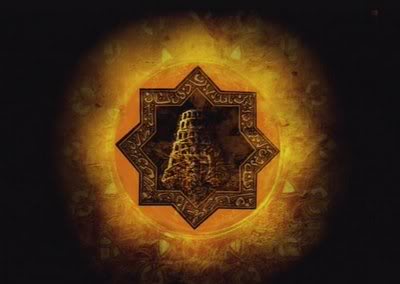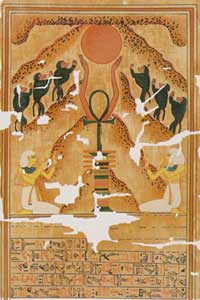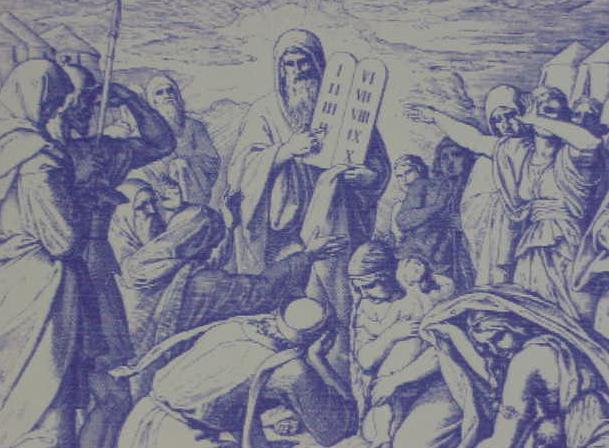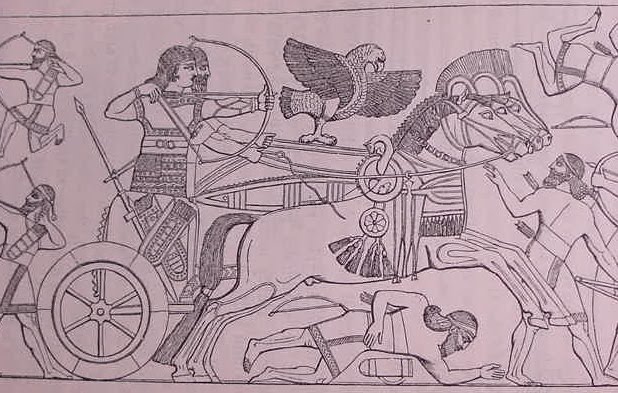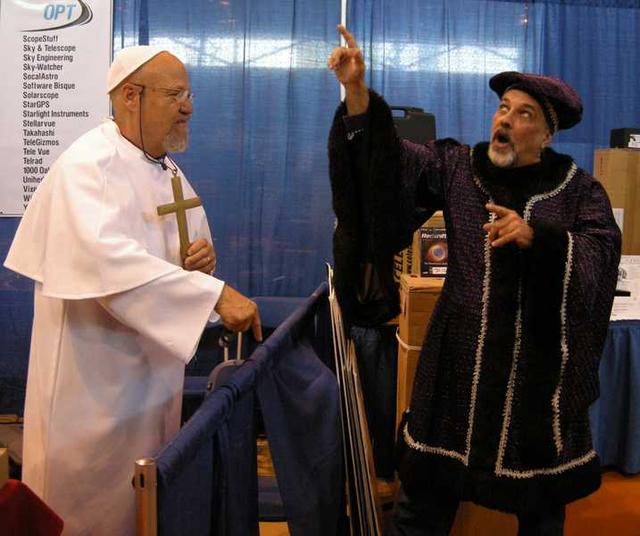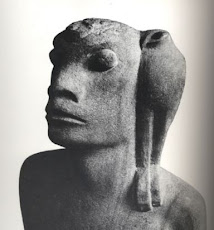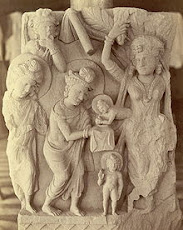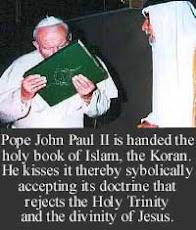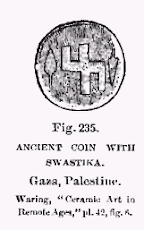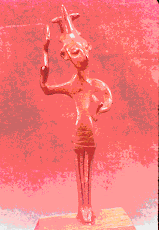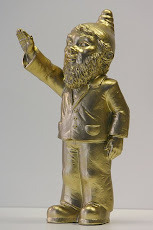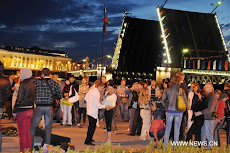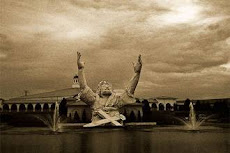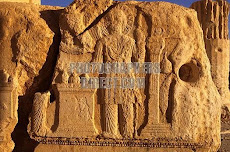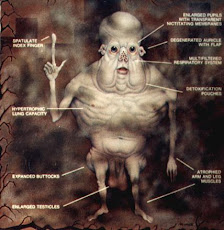In the ancient Babylonian astrological system, it is the Sun-god who is the ruler and main god of the zodiac. And all the gods of heaven (the stars) were considered offspring of the sun. According to pagan philosophy, all the star gods you have heard about in school were actually manifestations of the heat, fire and light which flowed from the sun. It was believed that it was the Sun-god who was the source of all things, and all the other gods were but emanations of the sun, "flesh of his flesh." Therefore, all the manifestations of the gods of nature were just manifestations of the one god, the Sun, whose worship by primitive man was in reality to Satan. Even Lucifer's name means "Day Star," the "Illuminated One," or "Shining One" (Young's Analytical Concordance to the Bible, Young, 1970, p.806)
This global solar religion of Nature is reflected in various languages. Salverte in his Des Sciences Occultes, observed: "Almost all the Tartar princes, trace their genealogy to a celestial virgin, impregnated by a sun-beam, or some equally miraculous means." In India, the mother of Surya, the sun-god, who was born to destroy the enemies of the gods, is said to have become pregnant in this way, a beam of the sun having entered her womb, in consequence of which she brought forth the sun-god.”
The name of Persian sun god Sure is cognate with Chaldean zuhr (“to shine”), zuhro (“the Shiner” cp. Zorro) and, of course zuro (“the seed”) because a beam of light was also an impregnating seed. The name Pyrisoporus, as aplied to Bacchus, means Ignigena, or the “Seed of Fire”, and Ala-sporos, the “Seed of God”, is just a similar expression formed in the same way.
The name Aur-ora, in the physical sense, signifies also "pregnant with light"; and from "ohra," "to conceive" or be "pregnant," we have in Greek, the word for a wife. The name of the Anglo-Saxon Zernebogus means: "The Seed of the Prophet Cush". The common name of peoples who worshiped the pagan sun gods was Children of Light as against Children of Darkness i.e. the Jews who refused to worship the object in Nature, such as the sun. The God of the Bible never allowed any person to approach Him in worship through any of his created objects of nature! In fact, God firmly forbids it! The apostle Paul spoke directly to this subject, in Roman 1:21-24 “…when they knew God, glorified him not as God, neither were thankful; but became vain in their imaginations, and their foolish heart was darkened. Professing themselves to be wise, they became fools. And changed the glory of the incorruptible God into an image…” Then in verse 25, Paul cut the ground out of anyone who thinks they can worship the created object rather than God, when he said, “Who changed the truth of God into a lie, and worshiped the creature more than the Creator…”
Spontaneous Generation also referred to as abiogenesis, the theory that living things arise de novo without living parents from lifeless matter. The attempt of the ancients and medievals to explain the origin of lower forms of life from natural causes, rather than attributing it directly to a supermundane or divine power, was scientifically respectable. Pliny wrote: “We are so much at the mercy of Chance that Chance is our god”. Indeed, in ancient Greece, Tyche or Chance was not merely believed in but worshiped alongside the other gods and goddesses. The two greatest historians of antiquity, Thucidides and Polybius, took chance (with a small 'c') as a cardinal element for historical analysis; Plato and Aristotle, taking an ultimately theological view of the universe, equated chance with all that did not belong to the directly purposive act of god and man, that is, in effect, with physical law.
The Stoics were pantheists: “All are but parts of one stupendous whole, whose body Nature is, and God the Soul.” Would you call him Fate? Asks Seneca. You will not be wrong...Would you call him Providence? You will be right...Would you call him Nature? You will not be speaking falsely...Would you call him Universe? You will not be deceived. The favorite name was Zeus; under this name the most religious of the early Stoics, Cleantes hymned it. The Stoics were determinists.
Peculiar Cases of Spontaneous Generation
In the erotic cult of the Mare-goddess children were believed to enter into woman's womb as sudden gusts of wind; and Homer's authority was weighty enough to make educated Romans still believe, with Pliny, that Spanish mares could conceive by turning their hindquarters to the wind (Pliny, Natural History, IV.35 and VIII.67)
Rome embraced the myth of phoenix; the Romans believed that on its death a grub came out of its body which in due time became a perfect bird; and that the new phoenix brought to Egypt the bones of its parent in the nest of spices in which it had died, and laid them on the altar in the temple of the sun in Heliopolis. It then returned to Arabia to live in its turn for five hundred years, and die and give life again to another as before. The Christians saw in this story a type of the resurrection; and Clement, Bishop of Rome, quotes it as such in his Epistle to the Corinthians. In other words, the doctrine of resurrection is rooted in Mythology. Let me remind in this context that for Pope John Paul II said that evolution is more than a mere hypothesis. Obviously, in Pliny's Rome they still believe that chance is their god.
St. Thomas Aquinas accepted the spontaneous generation of living things from decaying matter. He also accepted the ancients' postulate that the active principle for such a power resides in some way in a celestial body. Since the sun's heat has a beneficial effect on the growth and development of living things, he thought that such heat could communicate the power of life to the slime of the earth. Not regarding the heavenly bodies as animated, however, he held that they could produce living things only in virtue of some higher power (De pot. 6.6 ad 10)
Let's peep deeper into Aquinas's mind. In the time of pope Leo I (Leo, Serm. XXI., De Nativ. Dom. p. 148), some of the Fathers of the Church said that “what rendered the festival of Christmas venerable was less the birth of Jesus Christ than a return, and, as they expressed it, the new birth of the sun.” It was on the same day that the birth of the Invincible Sun (Natalis solis invicti), was celebrated at Rome, as can be seen in the Roman calendars, published in the reign of Constantine and of Julian. Thus epithet 'Invictus' is the same as the Persians gave to this same god, whom they worshiped by the name of Mithra, and whom they believed to be born out of rock (petra genetrix). In other words, another case of spontaneous generation.
According to a widespread and circumstantial legend, Aquinas's teacher Albert the Great, by magical means, created an android – an artificial man, living, speaking, and answering all questions with such subtlety that St. Thomas, unable to answer its reasoning, broke it to pieces with his staff. (There is a matching Jewish legend about a Prague rabbi creating Golem). We find an echo of this legend in Aquinas's Summa Theologiae:”In light of man's rapidly increasing control over matter and energy, it would be in accord with such an analysis to hold that man might be able to dispose matter in such a way as to educe from it a living form. The living thing produced would then be the result of nature as well as of man's art (3a, 75.6 ad 1). Well, Polish poet Aleksander Wat, in his memoirs entitled My Age mentions that while he was imprisoned during WWII in the Moscow Lubianka prison he could borrow from the prison library books by St. Thomas Aquinas. Interestingly, the books by the French renowned Jesuit priest Teilhard de Chardin are exhibited in honorary place in the Moscow Museum of Atheism. De Chardin became the patron of the Cracow Universal Weekly while the paper was supervised by the then Karol Cardinal Wojtyla. (See also J. FARLEY , The Spontaneous Generation Controversy from Descartes to Oparin, J. Hopkins Univ. Press, Baltimore - London 1977).
The ancients asserted that life originated from the sun, and that everything when bathed in the light of the solar orb was capable of absorbing the solar life elements and later radiating them as flora and fauna. One philosophical concept regarded the sun as a parent and the planers as embryos still connected to the solar body by means of ethereal umbilical cords which served as channels to convey life and nourishment to the planets.
The Virgin mother, giving birth to the sun god which Christianity has so faithfully preserved, is a reminder of the inscription concerning her Egyptian prototype, Isis, which appeared on the Temple of Sais: “The fruit which I have brought forth is the Sun.” While the Vigin was associated with the Moon by the early pagans, there is no doubt that they also understood her position as a constellation in the heavens, for nearly all the peoples of antiquity credit her as being the mother of the sun, and they realized that although the moon could not occupy that position, the sign of Virgo could, and did, give birth to the sun out of her side (similarly, the Buddha was born out of his mother Maya's side) on the 25th day of December. The teacher of Aquinas, Albertus Magnus states, “We know that the sign of the Celestial Virgin rose over the horizon at the moment at which we fix the birth of our Lord Jesus Christ.”
Thus the esotericism of pagandom was embodied in Christianity; the Christian church blindly follows ancient customs, and when asked for a reason gives superficial and unsatisfactory explanations, either forgetting or ignoring the indisputable fact that each religion is based upon the secret doctrines of its predecessor. Christianity shares with Masonry the pagan cult of the sun.
The primitive mind, recognizing the beneficent power of the solar orb, adored it as the proxy of the Supreme Deity. Concerning the origin of sun worship, Albert Pike, 33º, writes in his Morals and Dogma: “To them he (the sun) was the innate fire of bodies, the fire of Nature. Author of Life, heat, and ignition, he was to them the efficient cause of all generation, for without him there was no movement, no existence, no form. He was to them immense, indivisible, imperishable, and everywhere present. It was their need of light, and of his creative energy, that was felt by all men; and nothing was more fearful to them than his absence. His beneficent influences caused his identification with the Principle of Good; and the Brahma of the Hindus, and Mithras of the Persians, and Athom, Amun, Phtha and Osiris, of the Egyptians, the Bel of the Chaldeans, the Adonai of the Phoenicians, the Adonis and Apollo of the Greeks, became but personifications of the Sun god, the regenerating Principle, image of that fecundity which perpetuates and rejuvenates the world's existence.” To the Egyptians the sun was the symbol of immortality, for, while it died each night, it rose again with each ensuing dawn.
Christianity and Masonry
In about 1103 B.C. Aeneas’s son Brutus migrated and reestablished his group in “the Great White Island” and built a capital city he named New Troy, now called London. The great patron of the Masons Henry IV informs his scholar that the Mystery was brought into England by Peter Gower (i.e. Pythagoras). The first British martyr St. Alban was at the same time Grand Master of the Masons appointed to the post by the Emperor in A.D. 300. In the Philosophical Origins of Gentile Theology Newton describes Jesus as “one of these prophets sent to call mankind back to the truth of the Pythagorean heliocentrism.” The Athenian orator Isokrates (4th century B.C.) observed: “On a visit to Egypt Pythagoras became a student of the religion of the people” (See also R.H. Brown, Stellar Theology and Masonic Astronomy. New York 1882, p. 31)
James D. Tabor in his The Jesus Dynasty (2006) observed: “The traditional English translation “carpenter” which goes back as early as William Tyndale's 1526 edition of the New Testament, is misleading. The Greek word tekton is a more generic term referring to a “builder.” It can include one who works with wood, but in its 1st-century Galilean context it more likely refers to a stone worker. The 2nd-century Protoevangelium of James refers to Joseph as a “builder of buildings.” Houses and buildings were built of stone. Wood was used sparingly, mostly for roof beams and doors, since wood was a scarce building material in the rocky terrain of Palestine. Jesus often drew upon images of stone building to illustrate his teachings. In one of his well-known stories he speaks of the wise man who in building a house digs a deep foundation and lays the solid stone foundation of the building upon bedrock (Lk 6:48). He appears to have been exposed to the building trades, and stonework of some type was most likely his trade.”
Interestingly over the door of the newly discovered tomb of Jesus in Jerusalem we see a symbol matching exactly the logo of the Berlin Masonic Lodge. Robert H. Brown in his Stellar Theology and Masonic Astronomy (New York D. Appleton & Co0. 1882) reminded: “Herodotus informs us...that the Egyptians were the first to discover the solar year, and to portion out its course into `12 parts...The Egyptians knew the true system of the universe. They were acquainted with the fact that the sun is the center of the solar system, and that the earth and other planets revolve about it in fixed orbits. They knew that the earth is of globular shape, and revolves on its own axis, thus producing day and night...They also seem to have understood the power of gravitation, and that the heavenly bodies are attracted to a center” (p.31) Appropriately, the Polish Masonic Lodge is called Copernicus and the Italian Lodge – Galileo. Upon rehabilitation of Galileo the Italian Lodge awarded pope John Paul II honorary membership.
According to this ancient Masonic tradition Copernicus described his “sun in the middle of all” as a god: “In the center of all rests the Sun. For who would place this lamp of a very beautiful temple in another or better place than this from which it can illuminate everything at the same time? As a matter of fact, not unhappily do some call it the lantern, others, the mind, and still others, the Leader of the World. Trismegistus calls it ‘visible God’; Sophocles’ Electra, ‘that which gazes upon all things.’ And so the sun, as if resting on a kingly throne, governs the family of stars which wheel around.” (De revolutionibus… I, 10). And Newton identified gravity with the spiritual body of Jesus Christ. But his physical body rests in peace in the Israeli Museum of Antiquities.
The Old Testament's response to the sun worship is the teaching concerning the creation of all things by the God of Israel; His continuing sovereignty over all things, which includes His maintenance of the sun's course (Ps 104:19; Jer 31:35; cp. Mt 5:45); His ability to alter that course (Josh 10:12; 2 Kg 20:9-11; Isa 38:8) and to withhold the sun's light from the earth (Job 9:7).
To the Egyptians the teaching of the Hebrew Torah was the insult to their most sacred institutions of their solar religion. That explains why the Jews were despised b y the Egyptians themselves, who, to insult them, said that the wicked god Typhon had two sons, Hierosolymus and Judaeus, and that from these the Jews were descended. Jesus answer to the Jewish people in the Gospel of John (8:42): “If God were your father, you would love me...Your father is the devil, and you do exactly what he wants. He has always been a murderer and a liar” echoes that ancient Egyptian calumny.
“And the city had no need of the sun, neither of the moon, to shine in it; for the glory of God did lighten it, and the Lamb is the light thereof.” (Rev 21:23)
Centuries before the Christian Era, the pagans revered the constellation of Aries (the Ram). Godfrey Higgins states: “This constellation was called the 'Lamb of God.' He was also called the 'Savior,' and was said to save mankind from their sins. He was always honored with the appellation of 'Dominus' or 'Lord.' He was called the 'Lamb of God which taketh away the sins of the world.' The devotees addressing him in their litany, constantly repeated the words, 'O Lamb of God, that taketh away the sin of the world, have mercy upon us. Grant us Thy peace.'” Therefore, the Lamb of God is a title given to the sun, who is said to be reborn every year in the Northern Hemisphere in the sign of the Ram. Especially in the Gospel of John, the most hostile of all Gospels to the Jews the phraseology of the ancient solar cult is abundantly applied to Jesus.”Life was the light of men” (Jn 1:4). “Light (i.e. Jesus) is come into the world.” (Jn 3:19). “A burning and shining light” (Jn 5:35). “A little while is the Light (Jesus) with you.” (Jn 12:35)
Paul in 1 Thessalonians 5:5 says: “Ye are all the children of light, and the children of the day: we are not of the night, nor of darkness.” Accordingly, Sunday became the holy day of week for the Christian Children of Light which was not to be the same as the Jewish Mosaic shabbat.
Bringing light into causal relationship with the sun, as all heliocentrists and votaries of the sun god do, conforms to the receptive capacity of human eye, but it misses this light which in the “darkness” of night leads “all the beasts of the forest to their food from God.” (Ps 104:20). The Nuer, an African nation, aware of the racist undertones of this teaching dividing people into good Children of Light and devilish Children of Darkness point out by their habits something else and good which nights bring to people and which is as important as dew for plants; for them events are marked by counting “sleeps” or by referring to the phases of the moon. “Sleeps” as time units seem a more logical reference to the passage of days than “suns” or days themselves. Insomniacs know very well the torturte of sleepless nights.
In more remote times, products now known to be poisonous were used to whiten the skin and thus making the people to look like the real Children of Light. For example, as early as 400 B.C.E. the Greeks whitened their skin with a face powder of lead carbonate. Poppea Sabin, the wife of Roman Emperor Nero, used this toxic substance to whiten her face. In the 16th century, arsenic was used by some Italian women to give their faces a translucent appearance. In other words they wanted to have shining faces like the sun queen Elizabeth I.
The skin is the body's largest organ, measuring some 20 feet for an average male and 17 square feet for an average female. It contains receptors that respond to pain, touch, and temperature. The skin is the body's first line of defense against heat, cold and trauma, as well as against toxins, chemicals, and pollutants. Ironically, the skin of these Children of Light has a potential enemy – their sun god.
A curious fact for the life of the Essenes emerges from a study of the Jubilees calendar; it began the year on the fourth day of the week, Wednesday, on the principle that it was only on that day that the heavenly luminaries were created, and thus one could not properly speak of “day and night” before that (Gen 1:14-19). In the Hindu myth, Kala and Akala, time and not-time, are two forms of Brahma, after he had produced the world or rather the sun as the first thing in the universe.
I think that German poet Goethe caught very well the deeper meaning of the Biblical teaching about the sun having been created only on the fourth day. He observed: “Experience is not something simple, and can never be purely objective, because it is our own active organization which first makes experience possible, in that our senses take up only definite impressions, definitely shaped, moreover, by themselves, (We may stimulate the optical nerve as we will, the impression is always “light”, and so in the case of the other senses), while our understanding also sifts, arranges and unites the impressions according to definite systems. There are many problems in the natural sciences on which we cannot with propriety speak, if we do not call in the aid of metaphysics.”
After years of experimentation with time sensing in the honeybee, von Frisch concluded that “we are dealing here with beings who, seemingly without needing a clock, possess a memory for time, dependent neither on a feeling of hunger nor an appreciation of the sun’s position, and which, like our own appreciation of time, seems to defy any further analysis.”
While experimenters may think they have totally isolated their potatoes and their oysters by shielding them from light and changes in barometric or thermal conditions, these organisms have subtle ways of sensing what is really happening in the world outside.
Sir Cyril Burt in Arthur Koestler's The Roots of Coincidence destroyed Newton's dogma inspired by the pagan heliolatry. In Query XXX at the end of his Opticks Newton, like all other members of the Royal Society wondered: “Why may not Nature change bodies into light and light into bodies?” Swift satirized the Royal Society in Gulliver's Travels as the Grand Academy of Lagado, whose members made plans for extracting sunshine from cucumbers.
Here are Sir Burt's words: “Our tactile perception of the gravitational effects of mass (e.g. a grain of sand falling onto the skin) requires a stimulus of at least 0.1 gram, say about 1020 ergs; the kinaesthetic sense (e.g. lifting a weight) is coarser still. On the other hand, the eye in rod-vision is sensitive to less than 5 quanta of radiant energy, about 10-10 ergs or rather less. In detecting energy therefore man's perceptual apparatus is 1030 times more sensitive than it is in detecting mass. Had the perception of mass been as delicate as the perception of energy, the identity of the two would have seemed self-evident instead of paradoxical. When seeing light we should at the same time have felt the pressure or impact of the photons, and mass and energy would from the outset have been regarded as merely two different ways of perceiving the same thing...” At the same time our eyes are immune to temperature changes; we don't wear gloves on our eyes.
Creatures like us who see only in visible light deduce that everyone in the entire Universe, including God, must see in visible light. But God who created the world and its abundance showed Moses a different light never seen by the pharaoh Akhenaten! He showed him the light, which makes it possible for the owl, a pair of binocular with wings, whose eyes make up a third of its head size, to become the “night watchmen of our gardens”*. And this means that the owl can see a mouse in the darkness of night from a distance of several hundred yards.
*On page 236-237 in the Dictionary of Symbols by J.E. Cirlot, the owl is described as follows, “In the Egyptian system of hieroglyphs, the owl symbolizes death, night, cold and passivity. It also pertains to the realm of the dead sun, that is, of the sun which has set below the horizon and which is crossing the lake or sea of darkness.”
The potto lives in the forests of western Africa. It usually sleeps during the day in hollow trees and hunts for food at night. The potto’s big protruding eyes help it see easily in the dark. And what about giant eyes of an Australian spider that can see an ant in black darkness of nights? Some animals also see in infrared, or with radically different kinds of eyes (barred, compound, iridescent, tabular, at the ends of stalks). The world that greets them looks totally different. (Google: Images, Night Life to see more night creatures)
The Biblical teaching about relativity of light wasn’t entirely silenced by the Gentile Theology – as Newton called heliocentrism – concocted at Anu-Heliopolis in cooperation with Damascus.
The difference between black and white is not a matter of color, but of how much light they reflect. The terms are relative, not absolute. Black and white are fundamentally the same thing; the difference is only in the relative amounts of light reflected, not in their color. The fraction of incident light that human skin reflects varies widely from individual to individual. Skin pigmentation is produced mainly by an organic molecule called melanin, which the body manufactures from tyrosine, an amino acid common in proteins.
Albinos suffer from a hereditary disease in which melanin is not made. Their skin and hair are milky white. The irises of their eyes are pink. Albino animals are rare in nature because their skins provide little protection against solar radiation, and because they lack protective camouflage. Albinos tend not to last long. They don't survive under the killing rays of Copernicus's sun god.
People of Northern European ancestry and people of Central African ancestry are equally black in the ultraviolet and in the infrared (Google: Images, Ultraviolet Light to see for yourself), where nearly all organic molecules, not just melanin, absorb light. Only in the visible, where many molecules are transparent, is the anomaly of white skin even possible. Over most of the spectrum, all humans are black. Interestingly, taking interferon for hepatitis may change a white man into a black one.
The Scripture speaks of the precious fruits put forth by the sun and moon (Dt.33:14) The precious things put forth by the moon refer to those plants that depend on moonlight, as some flowers, because in the Biblical lore the light of the moon is independent of the sunlight.
We have also many “children of darkness” among the flora. Flowers of the Hedge Bindweed open wide in early morning. But they usually close in the bright sunlight later in the day. Night-Blooming Cereus climbs walls and rocky ledges in the West Indies and other warm lands. Gardeners in Hawaii and the Far East also cultivate this type of cactus. Its creamy blossoms open only at night (Google: Images, Night Plants to see more pictures of such plants). The Holy Thorn of Glastonbury on Wearyall Hill blooms at the Winter Solstice and in May.
There is a particular organic pigment responsible for the absorption of light in such flowers as roses and violets – flowers so strikingly colored that they’re named after their hues. It’s called anthocyanin. Remarkably, a typical anthocyanin is red when placed in acid, blue in alkali, and violet in water. Thus, roses are red because they contain anthocyanin and are slightly acidic; violets are blue because they contain anthocyanin and are slightly alkaline.
Blue pigments are hard to come by in nature. The rarity of blue rocks or blue sands on earth is an illustration. Only the heavens radiate blue and declare the Glory of God. Keep in mind, there is dew for every blade of grass.
The mystery of long-range butterfly migration has been resolved by a team of scientists from Jerusalem’s Hebrew University Faculty of Agricultural, Food and Environmental Quality Sciences, the University of Massachusetts Medical School, the Czech Academy of Sciences and the University of California, Irvine.
In findings published in a recent issue of the magazine, Neuron, the researchers reported that the butterfly’s signal to migrate thousands of miles over several months comes specifically from ultraviolet light detection in the insect’s eye.
Clearly, the more we learn about life, the more we see evidence of often subtle, yet truly profound, design. Such insights move many to echo the Bible’s words of praise to the Creator: “I shall laud you because in a fair-inspiring way I am wonderfully made. Your works are wonderful, as my soul is very well aware.” Psalm 139:14
Saturday, January 31, 2009
Wednesday, January 28, 2009
Heliofascism
Click on the link to see Copernicus on a Nazi stamp
faculty.kirkwood.edu/ryost/worldwartwo.htm
Holy Ghost of the sun god Wotan descends on A. Hitler
mssadik73.blogspot.com/2008/03/adolf-hitler.html
A dove in the shape of swastika is the logo of the French diocese of Arras
http://arras.cef.fr/page-13021-logo-diocese.html
The Perennial Aryan Heliocentrism
"Vishnu in the form of the Solar active energy, neither ever rises nor sets, and is at once, the sevenfold Sun and distinct from it," says Vishnu Purana (Book II., Chap. 1 1). Shiva in his symbol linga is referred to as as fixed or immovable (dhruva). Shiva is worshiped in the form of the linga, in the center of the temple, or inner shrine.
The serpent Mantra, in the Aytareya-Brahmana, a passage which speaks of the earth as the Sarpa Rajni, the Queen of the Serpents, and "the mother of all that moves." These expressions refer to the fact that before our globe had become egg-shaped or round it was a long trail of cosmic dust or fire-mist, moving and writhing like a serpent. This, say the explanations, was the Spirit of God moving on the chaos until its breath had incubated cosmic matter and made it assume the annular shape of a serpent with its tail in its mouth -- emblem of eternity (vol II, chp. 10)
T. Campanella in his book Apologia pro Galileo argued: “According to the testimony of Laertius, Plutarch, Aristotle, and Galen, Pythagoras first announced to the Gentiles his marvelous doctrine of the motion of the earth, of the sun in the center, and of systems in heaven. He informs them that the moon is another earth, and that the four elements, not to mention water, exist in the stars. Copernicus began to develop his system from the preceding contributions of the Pythagoreans, motivated by the observations of Francesco Maria. The disciple of Pythagoras, Timaeus Locrus, demonstrated by mathematics the diurnal rotation of the earth, and Philolaus of Crotona – the annual revolution of the earth (also by mathematics!) Copernicus then added the motion of libration from the pattern of the motion devised by Thebit of Babylon and King Alphonso of Spain. That such a motion was necessary St. Thomas Aquinas also suggested in Metaphysics from statements of Simplicius.
“Aristotle testifies, that Pythagoras, who located the place of punishment in the center of the earth and made fire the cause of motion, described the earth as mobile and animate. So Ovid believes in “Metamorphoses”, Origin in his commentary on Ezechiel, and Plato. It is essential, if hell be in the center of the earth, for earth to be hot within, and, according to Gregory and others cited in the argument of St. Thomas, to be mobile. The interpretation of Galileo does not oppose the belief of St. Gregory, but rather that of Aristotle.”
The Aryan Romans vs. the Semitic Jews
In Dante’s De monarchia the “Divine Predestination” of the Roman people as the world ruling power is derived not from interpretations of the Hebrew prophets or from the appointments of Peter but from the genealogical tree of Aeneas and Creusa! Race and not religion is the decisive thing for Dante. Campanella, an early apologist of Galileo observed: “Love is foremost in attending to the change of the race; men and women are so joined together, that they bring forth the best offspring.” Campanella can be considered a father of the modern eugenics which goes hand in hand with the materialism of heliocentrism. Cicero considered Jews a nation condemned to eternal slavery (nationmibus nati servituti).
M. Palmieri argued in his book The Philosophy of Fascism, (Chicago 1936): The triumph of the idea of Order, of Authority, of equal justice under Law, saw the Empire of Augustus and of Trajanus give to mankind (!) for the first and only time in human history the life-enhancing blessing of political unity. The triumph of the Catholic Idea of salvation in Christ and through Christ and His Church saw the Empire of the Church give to mankind the life-inspiring blessing of spiritual unity. A spiritual power generated from those great Italian spirits who have been in the past the assertors of Rome’s immortal and eternal right to Empire, and the prophets of Rome’s third form of Empire, is the leaven which has brought about that fermentation of spiritual forces called Fascism… Providence chose the Italian land for this high destiny, nourishing a spark of divine truth in it “ab antico” and molding there a race wonderfully adapted in genius and intelligence for subjecting the whole world in Christian obedience…Italy is the priestly nation among the great body of redeemed peoples…Nor did the inhabitants of this peninsula give to other peoples merely divine gifts, but also every other civil and human good, and all the great intellects of Europe, who enhanced in any measure the glory of their countries, lit their lamps at the living flame of Italian genius.”
Both the Vatican Library and the Vatican Museums are the outcome of a vision of Graeco-Roman culture as the perfect, almost timeless expression of human creativity at its highest levels - thought and art - and as the precursor, at times almost the prefigurement, of Christanity, above all in the West. “(Guide to the Vatican Museums Gestione Vendita Publicazioni Musei Vaticani, Citta del Vaticano. 1979, o. 12) www.intothelight.org/answers/jesus-as-the-sin...
The Book of Nature vs. the Bible
St. Bernard of Clairvaux who tried to combine a mystical life of absorption in God with his friendship for those in misery could also commune with nature and say:
Believe me, for I know, you will find something far greater in the woods than in the books. Stones and trees will teach you that which you cannot learn from the masters.
In other words, instead of attending school, our children should roam the woods and associate with packs of animals, like the Buddha, who “lived like an animal” or, the later Celtic Merlin, sometimes called the Hairy Anchorite, who himself ran with the beasts of the forests, a prefiguration of Tarzan.
The French theologian Alain de Lille – Alanus de Insulis – discovered at the end of the 12th c., this formula which the ages to come would not forget: “God is an intelligible sphere, whose center is everywhere and whose circumference is nowhere.” The last chapter of the last book of Pantagruel referred to “that intellectual sphere, whose center is everywhere and whose circumference nowhere, which we call God.”
The thought that the divinity had written a book moved them to imagine that he had written two, and that the other one was the universe. At the beginning of the 17th c., Francis Bacon declared in his Advancement of Learning that God offered us two books so that we would not fall into error: the first, the volume of the Scriptures, reveals His will; the second, the volume of the creatures, reveals His power and is the key to the former. Bacon intended much more than the making of a metaphor; he believed that the world was reducible to essential forms (temperatures, densities, weights, colors), which formed, in a limited number, an abecedarium naturae or series of letters with which the universal text is written.
Philosophy, Galileo tells Sarsi in the Assayer, is not like the Iliad or Orlando Furioso, books in which the least important thing is whether what is written is true. Galileo’s works abound with the concept of the universe as a book.
The second section of Favaro’s anthology (Galileo Galilei: Pensieri, motti e sentenze; Florence, 1949) is entitled Il libro della Natura. I quote the following paragraph: “Philosophy is written in that very large book that is continually opened before our eyes (I mean the universe), but which is not understood unless first one studies the language and knows the characters in which it is written. The language of that book is mathematical and the characters are triangles, circles, and other geometric figures.” Can anybody translate the Decalogue into the language of Galileo's Book of Nature? Natural History is obviously evolutionism.
Back to Nature
According to the Jesuit Juan de Mariana (b. 1536) man in the state of nature would be man stripped of all the clothing time has put upon him, divested of all specific habits and notions that belong to particular times, thrust outside all circumstance that is not permanent, at once an absolute and a mere potentiality. Nothing of man would there remain but which is at all times. There was a time, he says, when men lived as the animals; they lived without law or government and therefore without rights or property as the animals do. In fact they were animals; he implies quite distinctly, that they were not fully human. Perhaps the most original thing in his book is the dim vision of man emerging from the semi-brute (ape-man) of the state of nature into a conscious of himself and of right and so into full humanity. It is perhaps significant that for him the inner light by which we know right from wrong was vox naturae rather than vox Dei.
In the English “Dialogues Between Cardinal Pope and Thomas Lupset” written bet. 1536 and 1538 Pole expresses doubt in the life of civility. It seems to him that man was not born for civilization, but rather to live in a wild forest, then mere following the study of virtue, as it is said men did in the Golden Age. “A time there was, Master Lupset,” says Pole, “when man without city or town, law or religion, wandered abroad in the wild fields and woods, not otherwise than you see now brute beats to do”. In this condition he “long continued for many years, till he came at length to some order and civility and so gradually, “in long time, by little and little to the civilization that is now.” Darwinism is, obviously, an old hat!
In the early 1920's “ape-man” Hesperopithecus (which consisted of a single tooth) was pictured in the London Illustrated News complete with the tooth's wife, children, domestic animals, and cave! This tooth known as “Nebraska man” was still used by evolutionists as compelling evidence for human evolution during the time of the Scopes trial in 1925, but in 1927 parts of the skeleton were found and Nebraska man was downgraded to an extinct pig!
Heliocentric astronomy of Copernicus did not succeed the geocentered astronomy of Ptolemy because Copernicus’s system corresponded to experience and Ptolemy’s didn’t. With sufficient epicycles Ptolemy’s system could be made to correspond to our observations. The Copernican heliocentrism had won for political reasons. The fight against the religious heritage of the Hebrew Bible was what united the Roman Catholics and the Muslims. Very early we observe the growing alienation of the Roman Church from the Old Testament and Hebrew roots because of the Hellenization and universalization of the Christian message. On the other side, for the millions of Muslims Abraham was neither Jew nor Christian, but the first Muslim. He was believed to have founded the Kaaba in Mecca as the central sanctuary of the one God, and in this way he became the ancestor of the Arabs. On this political premise, the 12th-century Arab philosopher Averroës based his criticism of the Ptolemaic system and of the Biblical geocentrism for that matter: “Therefore new research work is necessary in order to find the “true” astronomy, which can be derived from the true principles of physics. As a matter of fact, today there is no astronomy at all, and what we call astronomy is in agreement with our computations but not with the physical reality.” Popular myth saw Averroës as a vile atheist. Interestingly, Voltaire who admired Pope Benedict XIV’s “enlightenment” dedicated to Averroes his tragedy Mahomet.
Averroes advocated the principle of non overlapping magisteria, of twofold truth (later embraced by the Renaissance neo-pagans) maintaining that religion has one sphere and philosophy another. Religion he said is for the unlettered multitude, philosophy for the chosen few. Religion teaches by signs and symbols; philosophy presents the truth itself. And that explains why the Bolsheviks titled their organ Pravda (The Truth).
In the opinion of Prof. Becker it would have been impossible for the Philosophes to have permitted God the father to fade away into the thin abstraction of a First Cause unless they were prepared to dispense with his revelation to men – the revelation through Holy Writ and Holy Church. Renunciation of the traditional revelation was the very condition of being truly enlightened; for to be truly enlightened was to see the light in its fullness, and the light in its fullness revealed two very simple and obvious facts. One of these contained the sum of those negations which we understand so well – the fact that the supposed revelation of God’s purposes through Holy Writ and Holy Church was a fraud, or at best an illusion born of ignorance, perpetrated, or at least maintained, by the priests in order to accentuate the fears of mankind, and so hold it in subjection. The other fact contained the sum of those affirmations which we understand less easily – that God had revealed his purpose to men in a far more simple and natural, a far less mysterious and recondite way, through his works. To be enlightened was to understand this double truth, that it was not in Holy Writ, but in the great book of nature, open for all mankind to read, that the laws of God had been recorded. This is the new revelation, and thus at least we enter the secret door to knowledge.
Thomas Aquinas’s judgment of the Ptolemaic system sounds as a paraphrase of Averroës’s criticism: “The assumptions made by the astronomers are not necessarily true. Although these hypotheses seem to be in agreement with the observed phenomena we must not claim that they are true. Perhaps one could explain the observed motion of the celestial bodies in a different way which has not been discovered up to this time.”
The Bible is for the government of the people, by the people, and for the people.
(Wycliffe, Preface to first English tr. of the Bible, 1384)
Master Jan Hus, a teacher at Prague University, preached at the Bethlehem Chapel. For him, the Bible was the greatest paradigm for living and the highest authority. He promoted the idea of a poor church. Coming closer to the perfect world of God was supposed to be the purpose of earthly endeavors. According to Hus and his followers, the disintegration of contemporary life throughout the country was indicative of the imminent arrival of the Anti-Christ. The German teachers at Prague University did not agree with Hus’s opinions. They apparently complained to the Pope himself about the alleged Czech heretics.
The king initially supported Hus, but Hus’s criticism of the selling of indulgences and the worsening reputation of a kingdom where the king apparently stayed his hand over a heretic changed the situation. The pope declared an interdict (i.e. a ban on church ceremonies – funerals, weddings, christenings, etc.) on Prague for as long as Jan Hus resided there.
Jan Hus went to the Council of Constance, which had been called by the king’s brother Sigismund Luxemburg, in order to defend the rightness of the Bohemian remedy for the Church. His efforts were in vain. He did not convince the Church dignitaries, and he refused to renounce his opinions. On July 6, 1415, he was burned to death at Constance. Today, this date is commemorated as a national state holiday in the Czech Republic. The delegates at the council managed to end the papal schism.
Jan Hus: Final Declaration, July 1, 1415
I, Jan Hus, in hope a priest of Jesus Christ, fearing to offend God, and fearing to fall into perjury, do hereby profess my unwillingness to abjure all or any of the articles produced against me by false witnesses. For God is my witness that I neither preached, affirmed, nor defended them, though they say that I did. Moreover, concerning the articles that they have extracted from my books, I say that I detest any false interpretation which any of them bears. But inasmuch as I fear to offend against the truth, or to gainsay the opinion of the doctors of the Church, I cannot abjure any one of them. And if it were possible that my voice could now reach the whole world, as at the Day of Judgment every lie and every sin that I have committed will be made manifest, then would I gladly abjure before all the world every falsehood and error which I either had thought of saying or actually said!
I say I write this of my own free will and choice.
Written with my own hand, on the first day of July.
Seek the truthListen to the truthTeach the truthLove the truthAbide by the truthAnd defend the truthUnto death.~ John Hus
Truth, crushed to earth, will rise again.~ William Cullen Bryant
What a contrast to Galileo's cowardice! He was probably inspired by the Fifth Dalai Lama, the heliofascist like himself who introduced his autobiography (Secret Biography) with an irony which undermined his own life's work in the following verses:
The erudite should not read this work, they will be embarrassed.
It is only for the guidance of fools who revel in fanciful ideas.
www.traditioninaction.org/SOD/j178sd_JohnNepo...
www.kevinstilley.com/truth-select-quotes/
A 19th-century Polish historian stated boldly: “Even in the 16th century Polish literature was still written in Latin or was merely an adaptation of Latin patterns. There arose paradoxical situation that men loving in their hearts God of Truth, in their writings proclaimed glory of Apollo, Bacchus and other heathen deities.” Exactly like the Cracow Academy and its most illustrious student N. Copernicus.In historical reality, however, their paganism was always gaining the upper hand.
For instance, at the Council of Constance, Paul Vlodkovits, the Rector of the Cracow University defended the pagans’ right to existence and declared the practice of forcible conversion to be unchristian. But at the same time, he demanded John Hus to be burned at the stake, because he mined the Hebrew Bible for inspiration and regarded the Jews as his natural allies.
Prague and Cracow rose to international fame during the ensuing centuries, the first by preparing, with John Hus at its head, the intellectual climate for the Protestant Reformation; the second by sheltering Copernicus, the father of the Counter-Reformation which, in later historical development culminated in the Jewish Holocaust during WW II.
Interestingly, the Cracow University, also known as Jagiellonian University, was inaugurated by rector Stanislaw of Skalbmierz as a “sanctuary of Apollo's Muses.” Copernicus's seal shows one of those Muses. And Apollo became his god “seated in the middle of all and ruling his family of stars.”
The writer of the Martyrdom of George of Cappadocia makes the spirit to raise up from the dead a pagan called Boes, who had been dead two hundred years, and who told Dadianus, the governor that he had been on earth a worshiper of the “stupid, dumb, deaf, and blind Apollo.” NASA rehabilitated Apollo; Pope John Paul II rehabilitated Galileo for what he was awarded the title Man of the Year (1994) by the Time magazine.
www.flickr.com/photos/kainet/530100860/
astrology.about.com/od/foundations/ig/Zodiac-...
www.ourworldtravels.com/czech/orloj.html
These are close-up images of the Prague Orloj, or Astronomical Clock. The clock was first created in 1410, with additions and repairs made over the centuries since then. There are three components of the clock, which is located at the Prague Town Hall. One is an astronomical clock, with hands following the Sun, Moon, and their movement through the Zodiac. There's also a calendar dial with gold medallions for of the months of the year. The third section has moving sculptures of the Apostles, and is called Walk of the Apostles.
The Hussite movement commemorated their national revival tied the the Bible by the geocentric clock constructed as early as 1410 by Miklush of Kadan is the symbol of John Hus’s revolution which regarded as the supreme head of the Church on earth not the Pope, but Jesus, the Defender of the Bible*. On the astronomical dial of Prague, the movement of the starry skies around the earth is shown by a smaller, eccentric ring that is marked with the signs of the constellations (the Latin term firmamentum used by Jerome in his Vulgate suggests the heliocentric immobility of the starry skies i.e. fixed stars). Fixed, in the middle of the face is the earth, including its meridians, parallels, and poles, with Prague at the center. On the face are also three circles representing the equator and the Tropics of Cancer and Capricorn. The dial thus shows the relative positions of earth, moon, and stars throughout the year. Below the astronomical dial is the calendar disk, on which country scenes are painted to depict each month of the year. Every hour on hour from eight in the morning until eight at night, this amazing mechanism springs to life. At the end of WWII, Nazi forces tried to destroy the astronomical clock by setting fire to the Old Town Hall. Pope John Paul II tried to put this clock into oblivion by rehabilitating Galileo…
* In a speech delivered Feb. 2, 1994 (See National Catholic Register, March 20, 1994) Card. J. Ratzinger stressed: “The Catechism thus connects the special mission of Jesus to His fidelity to the Torah; it sees in Him the servant of God who truly brings justice (Is 42:3)…This perfect fulfillment includes Jesus taking upon Himself the “curse of the Law” incurred by those who do not abide by the things written in the Book of the Law, and do them (Gal. 3:10). And listen to this: “Where the conflict between Jesus and the Judaism of His time is presented in a superficial, polemical way, a concept of liberation is derived which can understand the Torah only as a slavery to external rites and observances.”
Copernicus’s only motive in his research was his conviction that there was no established doctrine and, not a spirit of opposition against the established doctrine. That explains the fact that he joined to his book the letter he had received from Cardinal Schőnberg some years before and that he dedicated his work to Pope Paul III. Card. Schoenberg urged him to publish his book: “Thus, learned Sir, I hope that I will not be deemed a nuisance when I urgently request you to communicate your discovery to the learned world.” Tiedman Giese, Bishop of Kulm also insisted for a long time on publication. Copernicus’s brother Andreas was a high-ranking curialist…
01/16/2009 05:27 PM
ROTTEN IN THE STATE OF DENMARK
Was Tycho Brahe Murdered by a Contract Killer?
By Matthias Schulz
Over 400 years after the death of Danish astronomer Tycho Brahe, scientists in Prague are preparing to exhume his body. Was Europe's most renowned scholar poisoned with mercury? A Danish scholar claims to have decoded the murderer's diary.
Peter Andersen's new theory
But a new lead has emerged in the search for the killer. Peter Andersen, a Strasbourg German Studies expert, has studied all individuals who were in contact with the Prague court astronomer. Andersen also says he's identified the killer: Erik Brahe, a Swedish count. Historians traditionally consider him a "friend" and "affectionate cousin" of Tycho Brahe. He was in Brahe's house shortly before the astronomer's death.
Johannes Kepler, later used Brahe's accumulated observations to confirm and better the Copernican system, which Brahe himself had rejected.
On the 16th of August 1820, the Congregation of the Holy Office reported that Settele, the professor of astronomy at Rome and Washington might teach (Venia legendi) the Copernican system as truth established. This meant promotion of T.Paine’s anti-Semitism based on his admiration for philosophical heliocentrism and contempt for “barbarity” of Jewish Biblical culture. Quite recently Pope John Paul II recognized evolutionary hypothesis also as truth established.
THE SOLAR SYSTEM WITHOUT PLUTO
Stephen CauchiAugust 26, 2006
THE WORLD is coming to grips with the news that Pluto is a planet no more.
Thursday's decision by the International Astronomical Union meeting in Prague to strip Pluto of its planetary status, held since its discovery in 1930, has saddened those with a sentimental attachment to it. But most astronomers applaud the decision.
Aleksander WolszczanSeptember 25, 2008 4:30 PM Subscribe
In 1992, Aleksander Wolszczan discovered the first planets outside our solar system. Now, the Penn State professor been accused of spying for SB, the Polish Secret Police. He calls it a "smear campaign."posted by up in the old hotel (6 comments total) 1 user marked this as a favorite
“I actually had this guy for an astro class last semester, which was basically a class about aliens. I always thought he seemed cool but cool enough to be on a postage stamp?”
Wolszczan's discovery of the pulsar PSR B1257+12 being orbited by two planets with masses at least 3.4 and 2.8 times that of Earth mass echoes similar event of 1943. By Christmas of 1943, medium Maris Orsic of the Vril Gesellschaft, claimed that subsequent transmission from Aldebaran revealed there were two habitable planets orbiting that star and that the ancient Mesopotamian civilization of Sumeria was linked to earlier colonies of Aldebaran explorers. The seers discovered that the Aldebaran written language was identical to that of the Sumerians and was phonetically similar to that of spoken German.
T. Campanella in his Apologia pro Galileo was well aware that Galileo's inspiration for seeing the detail of the moon that is invisible was derived from the same source as Muhammad's claim about billions upon billions of virgins inhabiting the “heavenly bodies” built of four philosophical elements. He wrote:
“Galileo also says that water exists on the Moon and the planets which cannot be. These bodies are incorruptible, for do not all scholastics contend with Aristotle that they endure without change throughout all time? He describes land and mountains in the Moon and other celestial globes, and not only vilifies immeasurably the homes of the angels, but lessens our hope regarding Heaven.
“If the four elements which form our world exist in the stars, it follows from the doctrine of Galileo that, as Mohammed declared, there are many world with lands and seas and with human inhabitants. However, Scripture speaks of only one world and of one created man, so that this belief is opposed to Scripture. I pass without comment the opinion that Galileo has revived the heresy that Christ must make atonement for the men who inhabit the stars and die there again; just as formerly it was said that Christ must be crucified a second time in the antipodes, if the men living there were to be saved as we have been saved.”
Muhammad, for political reasons, rejected the idea of the Biblical Eden planted by God on earth and embraced instead the idea of the garden of Immortality that the Babylonian myth placed in Heaven. Unlike the Biblical Adam who was simply “sent forth from the garden of Eden” (Gen. 3:23), the Koran’s Adam was “sent down from the garden” (Sura Ta-Ha 20:123). Similarly, in the so-called Gospel of Marcion Jesus was send down, maybe from a “hanging, heavenly garden”, like a certain Clark Kent who can live in Smallville, like huris can live up there:
The sudden demotion of A. Wolszczan is a serious challenge to pope John Paul II's scientific legacy but is understandable in the context of the new Russian Patriarch who rejected darwinism.
According to the ecumenical Declaration the Orthodox Patriarch Alexei said to Y. Arafat during a meeting with him: “Please, believe that ‘the God of Abraham, Isaac and Jacob,’ as Pascal put it, and not the God of the philosophers and learned men, will come to you one day, will take you by the hand and guide you, if you truly wish it.” Possibly, the Patriarch alluded critically to John Paul II’s theology as proclaimed in his book Crossing the Threshold of Hope. But one has to keep in mind that Col 2:8 rejected philosophy as “the tradition of men…and not after Christ.”
Metropolitan Kyrill attacks Darwinism
In an interview for the German Spiegel Online published January 10, 2008 entitled The Bible Calls it a Sin Metropolitan Kyrill, foreign minister of the Russian Orthodox Church asked how he would approach Darwin's theories if he were a teacher, answered: “I would say that the theory has many adherents, but also a few unanswered questions. For instance, no one has provided precise proof of the transition from one species to another. It would be wrong to treat Darwin's theory as the only correct one. It is the leading theory today, but it could be replaced by another theory tomorrow. There was also a time when Marxism considered itself the only correct and scientifically justified theory...” Then, when Patriarch Alexei passed away, Metropolitan Kyrill was elected an interim Patriarch of Russia.
Metropolitan Kirill elected as 16th Patriarch of Moscow and all Russia
27.01.2009, 22.25
MOSCOW, January 27 (Itar-Tass) -- Sixty-two-year-old Metropolitan Kirill of Smolensk and Kaliningrad has been elected as the 16th Patriarch of Moscow and all Russia with 508 votes out of 701 at the Local Council of the Russian Orthodox Church, Metropolitan Isidor of Yekaterinodar and Kuban said.
One thing is certain. Unlike pope John Paul II, he will be considered a friend of the Turkish people, whom Darwin considered a subhuman race. The Turkish publicist Harun Yahya savages Darwin in his books and articles distributed in all areas of the Muslim World, and especially of the Turkic nations inhabiting the vast areas between the Meditarrenan Sea nd the Pacific.
faculty.kirkwood.edu/ryost/worldwartwo.htm
Holy Ghost of the sun god Wotan descends on A. Hitler
mssadik73.blogspot.com/2008/03/adolf-hitler.html
A dove in the shape of swastika is the logo of the French diocese of Arras
http://arras.cef.fr/page-13021-logo-diocese.html
The Perennial Aryan Heliocentrism
"Vishnu in the form of the Solar active energy, neither ever rises nor sets, and is at once, the sevenfold Sun and distinct from it," says Vishnu Purana (Book II., Chap. 1 1). Shiva in his symbol linga is referred to as as fixed or immovable (dhruva). Shiva is worshiped in the form of the linga, in the center of the temple, or inner shrine.
The serpent Mantra, in the Aytareya-Brahmana, a passage which speaks of the earth as the Sarpa Rajni, the Queen of the Serpents, and "the mother of all that moves." These expressions refer to the fact that before our globe had become egg-shaped or round it was a long trail of cosmic dust or fire-mist, moving and writhing like a serpent. This, say the explanations, was the Spirit of God moving on the chaos until its breath had incubated cosmic matter and made it assume the annular shape of a serpent with its tail in its mouth -- emblem of eternity (vol II, chp. 10)
T. Campanella in his book Apologia pro Galileo argued: “According to the testimony of Laertius, Plutarch, Aristotle, and Galen, Pythagoras first announced to the Gentiles his marvelous doctrine of the motion of the earth, of the sun in the center, and of systems in heaven. He informs them that the moon is another earth, and that the four elements, not to mention water, exist in the stars. Copernicus began to develop his system from the preceding contributions of the Pythagoreans, motivated by the observations of Francesco Maria. The disciple of Pythagoras, Timaeus Locrus, demonstrated by mathematics the diurnal rotation of the earth, and Philolaus of Crotona – the annual revolution of the earth (also by mathematics!) Copernicus then added the motion of libration from the pattern of the motion devised by Thebit of Babylon and King Alphonso of Spain. That such a motion was necessary St. Thomas Aquinas also suggested in Metaphysics from statements of Simplicius.
“Aristotle testifies, that Pythagoras, who located the place of punishment in the center of the earth and made fire the cause of motion, described the earth as mobile and animate. So Ovid believes in “Metamorphoses”, Origin in his commentary on Ezechiel, and Plato. It is essential, if hell be in the center of the earth, for earth to be hot within, and, according to Gregory and others cited in the argument of St. Thomas, to be mobile. The interpretation of Galileo does not oppose the belief of St. Gregory, but rather that of Aristotle.”
The Aryan Romans vs. the Semitic Jews
In Dante’s De monarchia the “Divine Predestination” of the Roman people as the world ruling power is derived not from interpretations of the Hebrew prophets or from the appointments of Peter but from the genealogical tree of Aeneas and Creusa! Race and not religion is the decisive thing for Dante. Campanella, an early apologist of Galileo observed: “Love is foremost in attending to the change of the race; men and women are so joined together, that they bring forth the best offspring.” Campanella can be considered a father of the modern eugenics which goes hand in hand with the materialism of heliocentrism. Cicero considered Jews a nation condemned to eternal slavery (nationmibus nati servituti).
M. Palmieri argued in his book The Philosophy of Fascism, (Chicago 1936): The triumph of the idea of Order, of Authority, of equal justice under Law, saw the Empire of Augustus and of Trajanus give to mankind (!) for the first and only time in human history the life-enhancing blessing of political unity. The triumph of the Catholic Idea of salvation in Christ and through Christ and His Church saw the Empire of the Church give to mankind the life-inspiring blessing of spiritual unity. A spiritual power generated from those great Italian spirits who have been in the past the assertors of Rome’s immortal and eternal right to Empire, and the prophets of Rome’s third form of Empire, is the leaven which has brought about that fermentation of spiritual forces called Fascism… Providence chose the Italian land for this high destiny, nourishing a spark of divine truth in it “ab antico” and molding there a race wonderfully adapted in genius and intelligence for subjecting the whole world in Christian obedience…Italy is the priestly nation among the great body of redeemed peoples…Nor did the inhabitants of this peninsula give to other peoples merely divine gifts, but also every other civil and human good, and all the great intellects of Europe, who enhanced in any measure the glory of their countries, lit their lamps at the living flame of Italian genius.”
Both the Vatican Library and the Vatican Museums are the outcome of a vision of Graeco-Roman culture as the perfect, almost timeless expression of human creativity at its highest levels - thought and art - and as the precursor, at times almost the prefigurement, of Christanity, above all in the West. “(Guide to the Vatican Museums Gestione Vendita Publicazioni Musei Vaticani, Citta del Vaticano. 1979, o. 12) www.intothelight.org/answers/jesus-as-the-sin...
The Book of Nature vs. the Bible
St. Bernard of Clairvaux who tried to combine a mystical life of absorption in God with his friendship for those in misery could also commune with nature and say:
Believe me, for I know, you will find something far greater in the woods than in the books. Stones and trees will teach you that which you cannot learn from the masters.
In other words, instead of attending school, our children should roam the woods and associate with packs of animals, like the Buddha, who “lived like an animal” or, the later Celtic Merlin, sometimes called the Hairy Anchorite, who himself ran with the beasts of the forests, a prefiguration of Tarzan.
The French theologian Alain de Lille – Alanus de Insulis – discovered at the end of the 12th c., this formula which the ages to come would not forget: “God is an intelligible sphere, whose center is everywhere and whose circumference is nowhere.” The last chapter of the last book of Pantagruel referred to “that intellectual sphere, whose center is everywhere and whose circumference nowhere, which we call God.”
The thought that the divinity had written a book moved them to imagine that he had written two, and that the other one was the universe. At the beginning of the 17th c., Francis Bacon declared in his Advancement of Learning that God offered us two books so that we would not fall into error: the first, the volume of the Scriptures, reveals His will; the second, the volume of the creatures, reveals His power and is the key to the former. Bacon intended much more than the making of a metaphor; he believed that the world was reducible to essential forms (temperatures, densities, weights, colors), which formed, in a limited number, an abecedarium naturae or series of letters with which the universal text is written.
Philosophy, Galileo tells Sarsi in the Assayer, is not like the Iliad or Orlando Furioso, books in which the least important thing is whether what is written is true. Galileo’s works abound with the concept of the universe as a book.
The second section of Favaro’s anthology (Galileo Galilei: Pensieri, motti e sentenze; Florence, 1949) is entitled Il libro della Natura. I quote the following paragraph: “Philosophy is written in that very large book that is continually opened before our eyes (I mean the universe), but which is not understood unless first one studies the language and knows the characters in which it is written. The language of that book is mathematical and the characters are triangles, circles, and other geometric figures.” Can anybody translate the Decalogue into the language of Galileo's Book of Nature? Natural History is obviously evolutionism.
Back to Nature
According to the Jesuit Juan de Mariana (b. 1536) man in the state of nature would be man stripped of all the clothing time has put upon him, divested of all specific habits and notions that belong to particular times, thrust outside all circumstance that is not permanent, at once an absolute and a mere potentiality. Nothing of man would there remain but which is at all times. There was a time, he says, when men lived as the animals; they lived without law or government and therefore without rights or property as the animals do. In fact they were animals; he implies quite distinctly, that they were not fully human. Perhaps the most original thing in his book is the dim vision of man emerging from the semi-brute (ape-man) of the state of nature into a conscious of himself and of right and so into full humanity. It is perhaps significant that for him the inner light by which we know right from wrong was vox naturae rather than vox Dei.
In the English “Dialogues Between Cardinal Pope and Thomas Lupset” written bet. 1536 and 1538 Pole expresses doubt in the life of civility. It seems to him that man was not born for civilization, but rather to live in a wild forest, then mere following the study of virtue, as it is said men did in the Golden Age. “A time there was, Master Lupset,” says Pole, “when man without city or town, law or religion, wandered abroad in the wild fields and woods, not otherwise than you see now brute beats to do”. In this condition he “long continued for many years, till he came at length to some order and civility and so gradually, “in long time, by little and little to the civilization that is now.” Darwinism is, obviously, an old hat!
In the early 1920's “ape-man” Hesperopithecus (which consisted of a single tooth) was pictured in the London Illustrated News complete with the tooth's wife, children, domestic animals, and cave! This tooth known as “Nebraska man” was still used by evolutionists as compelling evidence for human evolution during the time of the Scopes trial in 1925, but in 1927 parts of the skeleton were found and Nebraska man was downgraded to an extinct pig!
Heliocentric astronomy of Copernicus did not succeed the geocentered astronomy of Ptolemy because Copernicus’s system corresponded to experience and Ptolemy’s didn’t. With sufficient epicycles Ptolemy’s system could be made to correspond to our observations. The Copernican heliocentrism had won for political reasons. The fight against the religious heritage of the Hebrew Bible was what united the Roman Catholics and the Muslims. Very early we observe the growing alienation of the Roman Church from the Old Testament and Hebrew roots because of the Hellenization and universalization of the Christian message. On the other side, for the millions of Muslims Abraham was neither Jew nor Christian, but the first Muslim. He was believed to have founded the Kaaba in Mecca as the central sanctuary of the one God, and in this way he became the ancestor of the Arabs. On this political premise, the 12th-century Arab philosopher Averroës based his criticism of the Ptolemaic system and of the Biblical geocentrism for that matter: “Therefore new research work is necessary in order to find the “true” astronomy, which can be derived from the true principles of physics. As a matter of fact, today there is no astronomy at all, and what we call astronomy is in agreement with our computations but not with the physical reality.” Popular myth saw Averroës as a vile atheist. Interestingly, Voltaire who admired Pope Benedict XIV’s “enlightenment” dedicated to Averroes his tragedy Mahomet.
Averroes advocated the principle of non overlapping magisteria, of twofold truth (later embraced by the Renaissance neo-pagans) maintaining that religion has one sphere and philosophy another. Religion he said is for the unlettered multitude, philosophy for the chosen few. Religion teaches by signs and symbols; philosophy presents the truth itself. And that explains why the Bolsheviks titled their organ Pravda (The Truth).
In the opinion of Prof. Becker it would have been impossible for the Philosophes to have permitted God the father to fade away into the thin abstraction of a First Cause unless they were prepared to dispense with his revelation to men – the revelation through Holy Writ and Holy Church. Renunciation of the traditional revelation was the very condition of being truly enlightened; for to be truly enlightened was to see the light in its fullness, and the light in its fullness revealed two very simple and obvious facts. One of these contained the sum of those negations which we understand so well – the fact that the supposed revelation of God’s purposes through Holy Writ and Holy Church was a fraud, or at best an illusion born of ignorance, perpetrated, or at least maintained, by the priests in order to accentuate the fears of mankind, and so hold it in subjection. The other fact contained the sum of those affirmations which we understand less easily – that God had revealed his purpose to men in a far more simple and natural, a far less mysterious and recondite way, through his works. To be enlightened was to understand this double truth, that it was not in Holy Writ, but in the great book of nature, open for all mankind to read, that the laws of God had been recorded. This is the new revelation, and thus at least we enter the secret door to knowledge.
Thomas Aquinas’s judgment of the Ptolemaic system sounds as a paraphrase of Averroës’s criticism: “The assumptions made by the astronomers are not necessarily true. Although these hypotheses seem to be in agreement with the observed phenomena we must not claim that they are true. Perhaps one could explain the observed motion of the celestial bodies in a different way which has not been discovered up to this time.”
The Bible is for the government of the people, by the people, and for the people.
(Wycliffe, Preface to first English tr. of the Bible, 1384)
Master Jan Hus, a teacher at Prague University, preached at the Bethlehem Chapel. For him, the Bible was the greatest paradigm for living and the highest authority. He promoted the idea of a poor church. Coming closer to the perfect world of God was supposed to be the purpose of earthly endeavors. According to Hus and his followers, the disintegration of contemporary life throughout the country was indicative of the imminent arrival of the Anti-Christ. The German teachers at Prague University did not agree with Hus’s opinions. They apparently complained to the Pope himself about the alleged Czech heretics.
The king initially supported Hus, but Hus’s criticism of the selling of indulgences and the worsening reputation of a kingdom where the king apparently stayed his hand over a heretic changed the situation. The pope declared an interdict (i.e. a ban on church ceremonies – funerals, weddings, christenings, etc.) on Prague for as long as Jan Hus resided there.
Jan Hus went to the Council of Constance, which had been called by the king’s brother Sigismund Luxemburg, in order to defend the rightness of the Bohemian remedy for the Church. His efforts were in vain. He did not convince the Church dignitaries, and he refused to renounce his opinions. On July 6, 1415, he was burned to death at Constance. Today, this date is commemorated as a national state holiday in the Czech Republic. The delegates at the council managed to end the papal schism.
Jan Hus: Final Declaration, July 1, 1415
I, Jan Hus, in hope a priest of Jesus Christ, fearing to offend God, and fearing to fall into perjury, do hereby profess my unwillingness to abjure all or any of the articles produced against me by false witnesses. For God is my witness that I neither preached, affirmed, nor defended them, though they say that I did. Moreover, concerning the articles that they have extracted from my books, I say that I detest any false interpretation which any of them bears. But inasmuch as I fear to offend against the truth, or to gainsay the opinion of the doctors of the Church, I cannot abjure any one of them. And if it were possible that my voice could now reach the whole world, as at the Day of Judgment every lie and every sin that I have committed will be made manifest, then would I gladly abjure before all the world every falsehood and error which I either had thought of saying or actually said!
I say I write this of my own free will and choice.
Written with my own hand, on the first day of July.
Seek the truthListen to the truthTeach the truthLove the truthAbide by the truthAnd defend the truthUnto death.~ John Hus
Truth, crushed to earth, will rise again.~ William Cullen Bryant
What a contrast to Galileo's cowardice! He was probably inspired by the Fifth Dalai Lama, the heliofascist like himself who introduced his autobiography (Secret Biography) with an irony which undermined his own life's work in the following verses:
The erudite should not read this work, they will be embarrassed.
It is only for the guidance of fools who revel in fanciful ideas.
www.traditioninaction.org/SOD/j178sd_JohnNepo...
www.kevinstilley.com/truth-select-quotes/
A 19th-century Polish historian stated boldly: “Even in the 16th century Polish literature was still written in Latin or was merely an adaptation of Latin patterns. There arose paradoxical situation that men loving in their hearts God of Truth, in their writings proclaimed glory of Apollo, Bacchus and other heathen deities.” Exactly like the Cracow Academy and its most illustrious student N. Copernicus.In historical reality, however, their paganism was always gaining the upper hand.
For instance, at the Council of Constance, Paul Vlodkovits, the Rector of the Cracow University defended the pagans’ right to existence and declared the practice of forcible conversion to be unchristian. But at the same time, he demanded John Hus to be burned at the stake, because he mined the Hebrew Bible for inspiration and regarded the Jews as his natural allies.
Prague and Cracow rose to international fame during the ensuing centuries, the first by preparing, with John Hus at its head, the intellectual climate for the Protestant Reformation; the second by sheltering Copernicus, the father of the Counter-Reformation which, in later historical development culminated in the Jewish Holocaust during WW II.
Interestingly, the Cracow University, also known as Jagiellonian University, was inaugurated by rector Stanislaw of Skalbmierz as a “sanctuary of Apollo's Muses.” Copernicus's seal shows one of those Muses. And Apollo became his god “seated in the middle of all and ruling his family of stars.”
The writer of the Martyrdom of George of Cappadocia makes the spirit to raise up from the dead a pagan called Boes, who had been dead two hundred years, and who told Dadianus, the governor that he had been on earth a worshiper of the “stupid, dumb, deaf, and blind Apollo.” NASA rehabilitated Apollo; Pope John Paul II rehabilitated Galileo for what he was awarded the title Man of the Year (1994) by the Time magazine.
www.flickr.com/photos/kainet/530100860/
astrology.about.com/od/foundations/ig/Zodiac-...
www.ourworldtravels.com/czech/orloj.html
These are close-up images of the Prague Orloj, or Astronomical Clock. The clock was first created in 1410, with additions and repairs made over the centuries since then. There are three components of the clock, which is located at the Prague Town Hall. One is an astronomical clock, with hands following the Sun, Moon, and their movement through the Zodiac. There's also a calendar dial with gold medallions for of the months of the year. The third section has moving sculptures of the Apostles, and is called Walk of the Apostles.
The Hussite movement commemorated their national revival tied the the Bible by the geocentric clock constructed as early as 1410 by Miklush of Kadan is the symbol of John Hus’s revolution which regarded as the supreme head of the Church on earth not the Pope, but Jesus, the Defender of the Bible*. On the astronomical dial of Prague, the movement of the starry skies around the earth is shown by a smaller, eccentric ring that is marked with the signs of the constellations (the Latin term firmamentum used by Jerome in his Vulgate suggests the heliocentric immobility of the starry skies i.e. fixed stars). Fixed, in the middle of the face is the earth, including its meridians, parallels, and poles, with Prague at the center. On the face are also three circles representing the equator and the Tropics of Cancer and Capricorn. The dial thus shows the relative positions of earth, moon, and stars throughout the year. Below the astronomical dial is the calendar disk, on which country scenes are painted to depict each month of the year. Every hour on hour from eight in the morning until eight at night, this amazing mechanism springs to life. At the end of WWII, Nazi forces tried to destroy the astronomical clock by setting fire to the Old Town Hall. Pope John Paul II tried to put this clock into oblivion by rehabilitating Galileo…
* In a speech delivered Feb. 2, 1994 (See National Catholic Register, March 20, 1994) Card. J. Ratzinger stressed: “The Catechism thus connects the special mission of Jesus to His fidelity to the Torah; it sees in Him the servant of God who truly brings justice (Is 42:3)…This perfect fulfillment includes Jesus taking upon Himself the “curse of the Law” incurred by those who do not abide by the things written in the Book of the Law, and do them (Gal. 3:10). And listen to this: “Where the conflict between Jesus and the Judaism of His time is presented in a superficial, polemical way, a concept of liberation is derived which can understand the Torah only as a slavery to external rites and observances.”
Copernicus’s only motive in his research was his conviction that there was no established doctrine and, not a spirit of opposition against the established doctrine. That explains the fact that he joined to his book the letter he had received from Cardinal Schőnberg some years before and that he dedicated his work to Pope Paul III. Card. Schoenberg urged him to publish his book: “Thus, learned Sir, I hope that I will not be deemed a nuisance when I urgently request you to communicate your discovery to the learned world.” Tiedman Giese, Bishop of Kulm also insisted for a long time on publication. Copernicus’s brother Andreas was a high-ranking curialist…
01/16/2009 05:27 PM
ROTTEN IN THE STATE OF DENMARK
Was Tycho Brahe Murdered by a Contract Killer?
By Matthias Schulz
Over 400 years after the death of Danish astronomer Tycho Brahe, scientists in Prague are preparing to exhume his body. Was Europe's most renowned scholar poisoned with mercury? A Danish scholar claims to have decoded the murderer's diary.
Peter Andersen's new theory
But a new lead has emerged in the search for the killer. Peter Andersen, a Strasbourg German Studies expert, has studied all individuals who were in contact with the Prague court astronomer. Andersen also says he's identified the killer: Erik Brahe, a Swedish count. Historians traditionally consider him a "friend" and "affectionate cousin" of Tycho Brahe. He was in Brahe's house shortly before the astronomer's death.
Johannes Kepler, later used Brahe's accumulated observations to confirm and better the Copernican system, which Brahe himself had rejected.
On the 16th of August 1820, the Congregation of the Holy Office reported that Settele, the professor of astronomy at Rome and Washington might teach (Venia legendi) the Copernican system as truth established. This meant promotion of T.Paine’s anti-Semitism based on his admiration for philosophical heliocentrism and contempt for “barbarity” of Jewish Biblical culture. Quite recently Pope John Paul II recognized evolutionary hypothesis also as truth established.
THE SOLAR SYSTEM WITHOUT PLUTO
Stephen CauchiAugust 26, 2006
THE WORLD is coming to grips with the news that Pluto is a planet no more.
Thursday's decision by the International Astronomical Union meeting in Prague to strip Pluto of its planetary status, held since its discovery in 1930, has saddened those with a sentimental attachment to it. But most astronomers applaud the decision.
Aleksander WolszczanSeptember 25, 2008 4:30 PM Subscribe
In 1992, Aleksander Wolszczan discovered the first planets outside our solar system. Now, the Penn State professor been accused of spying for SB, the Polish Secret Police. He calls it a "smear campaign."posted by up in the old hotel (6 comments total) 1 user marked this as a favorite
“I actually had this guy for an astro class last semester, which was basically a class about aliens. I always thought he seemed cool but cool enough to be on a postage stamp?”
Wolszczan's discovery of the pulsar PSR B1257+12 being orbited by two planets with masses at least 3.4 and 2.8 times that of Earth mass echoes similar event of 1943. By Christmas of 1943, medium Maris Orsic of the Vril Gesellschaft, claimed that subsequent transmission from Aldebaran revealed there were two habitable planets orbiting that star and that the ancient Mesopotamian civilization of Sumeria was linked to earlier colonies of Aldebaran explorers. The seers discovered that the Aldebaran written language was identical to that of the Sumerians and was phonetically similar to that of spoken German.
T. Campanella in his Apologia pro Galileo was well aware that Galileo's inspiration for seeing the detail of the moon that is invisible was derived from the same source as Muhammad's claim about billions upon billions of virgins inhabiting the “heavenly bodies” built of four philosophical elements. He wrote:
“Galileo also says that water exists on the Moon and the planets which cannot be. These bodies are incorruptible, for do not all scholastics contend with Aristotle that they endure without change throughout all time? He describes land and mountains in the Moon and other celestial globes, and not only vilifies immeasurably the homes of the angels, but lessens our hope regarding Heaven.
“If the four elements which form our world exist in the stars, it follows from the doctrine of Galileo that, as Mohammed declared, there are many world with lands and seas and with human inhabitants. However, Scripture speaks of only one world and of one created man, so that this belief is opposed to Scripture. I pass without comment the opinion that Galileo has revived the heresy that Christ must make atonement for the men who inhabit the stars and die there again; just as formerly it was said that Christ must be crucified a second time in the antipodes, if the men living there were to be saved as we have been saved.”
Muhammad, for political reasons, rejected the idea of the Biblical Eden planted by God on earth and embraced instead the idea of the garden of Immortality that the Babylonian myth placed in Heaven. Unlike the Biblical Adam who was simply “sent forth from the garden of Eden” (Gen. 3:23), the Koran’s Adam was “sent down from the garden” (Sura Ta-Ha 20:123). Similarly, in the so-called Gospel of Marcion Jesus was send down, maybe from a “hanging, heavenly garden”, like a certain Clark Kent who can live in Smallville, like huris can live up there:
The sudden demotion of A. Wolszczan is a serious challenge to pope John Paul II's scientific legacy but is understandable in the context of the new Russian Patriarch who rejected darwinism.
According to the ecumenical Declaration the Orthodox Patriarch Alexei said to Y. Arafat during a meeting with him: “Please, believe that ‘the God of Abraham, Isaac and Jacob,’ as Pascal put it, and not the God of the philosophers and learned men, will come to you one day, will take you by the hand and guide you, if you truly wish it.” Possibly, the Patriarch alluded critically to John Paul II’s theology as proclaimed in his book Crossing the Threshold of Hope. But one has to keep in mind that Col 2:8 rejected philosophy as “the tradition of men…and not after Christ.”
Metropolitan Kyrill attacks Darwinism
In an interview for the German Spiegel Online published January 10, 2008 entitled The Bible Calls it a Sin Metropolitan Kyrill, foreign minister of the Russian Orthodox Church asked how he would approach Darwin's theories if he were a teacher, answered: “I would say that the theory has many adherents, but also a few unanswered questions. For instance, no one has provided precise proof of the transition from one species to another. It would be wrong to treat Darwin's theory as the only correct one. It is the leading theory today, but it could be replaced by another theory tomorrow. There was also a time when Marxism considered itself the only correct and scientifically justified theory...” Then, when Patriarch Alexei passed away, Metropolitan Kyrill was elected an interim Patriarch of Russia.
Metropolitan Kirill elected as 16th Patriarch of Moscow and all Russia
27.01.2009, 22.25
MOSCOW, January 27 (Itar-Tass) -- Sixty-two-year-old Metropolitan Kirill of Smolensk and Kaliningrad has been elected as the 16th Patriarch of Moscow and all Russia with 508 votes out of 701 at the Local Council of the Russian Orthodox Church, Metropolitan Isidor of Yekaterinodar and Kuban said.
One thing is certain. Unlike pope John Paul II, he will be considered a friend of the Turkish people, whom Darwin considered a subhuman race. The Turkish publicist Harun Yahya savages Darwin in his books and articles distributed in all areas of the Muslim World, and especially of the Turkic nations inhabiting the vast areas between the Meditarrenan Sea nd the Pacific.
Subscribe to:
Comments (Atom)



















































































































































































































































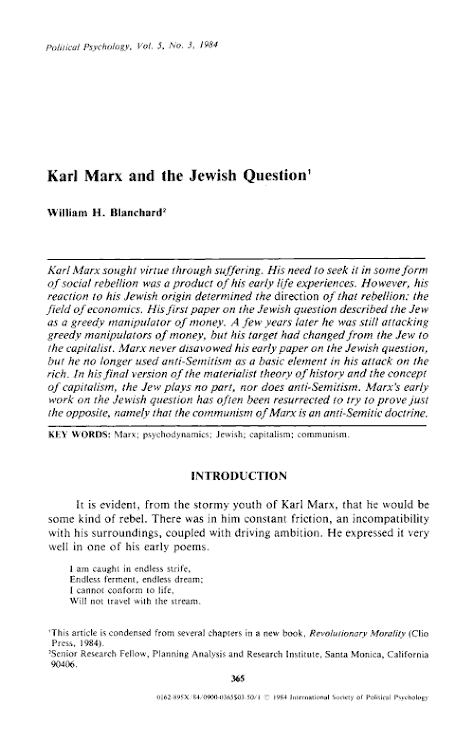











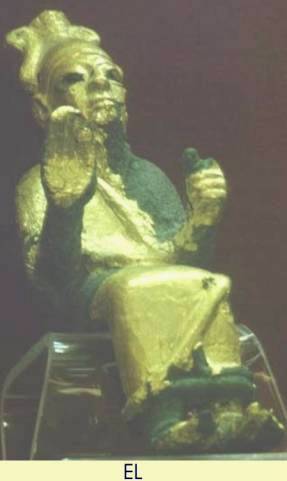

































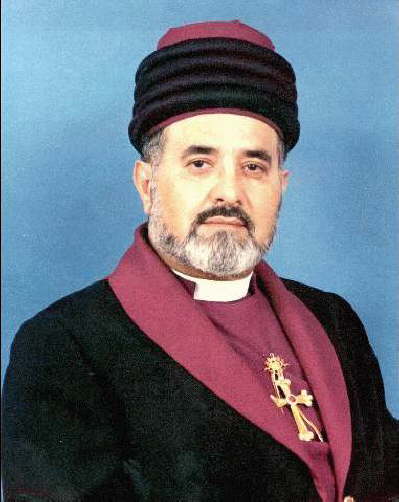+Anniversay+Dinner.jpg)





